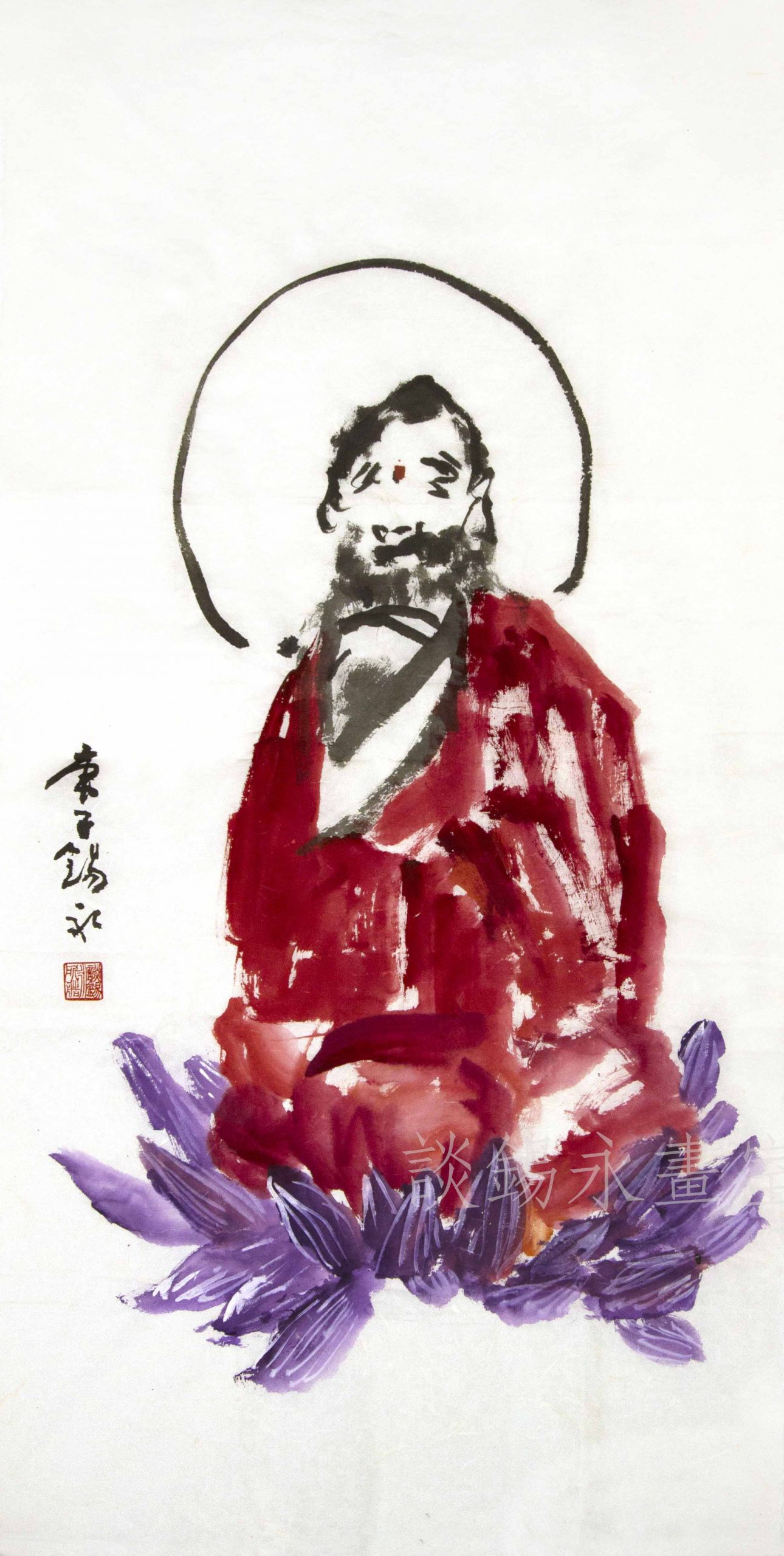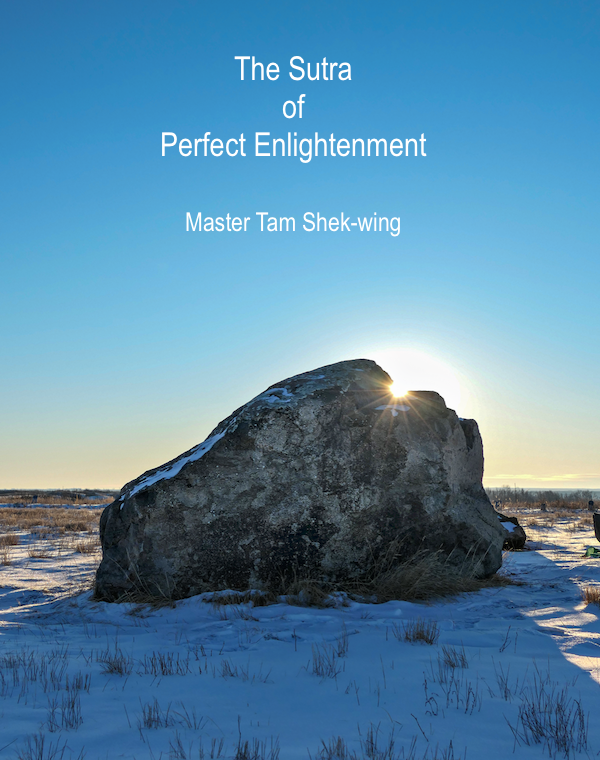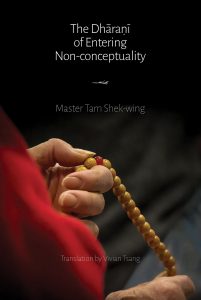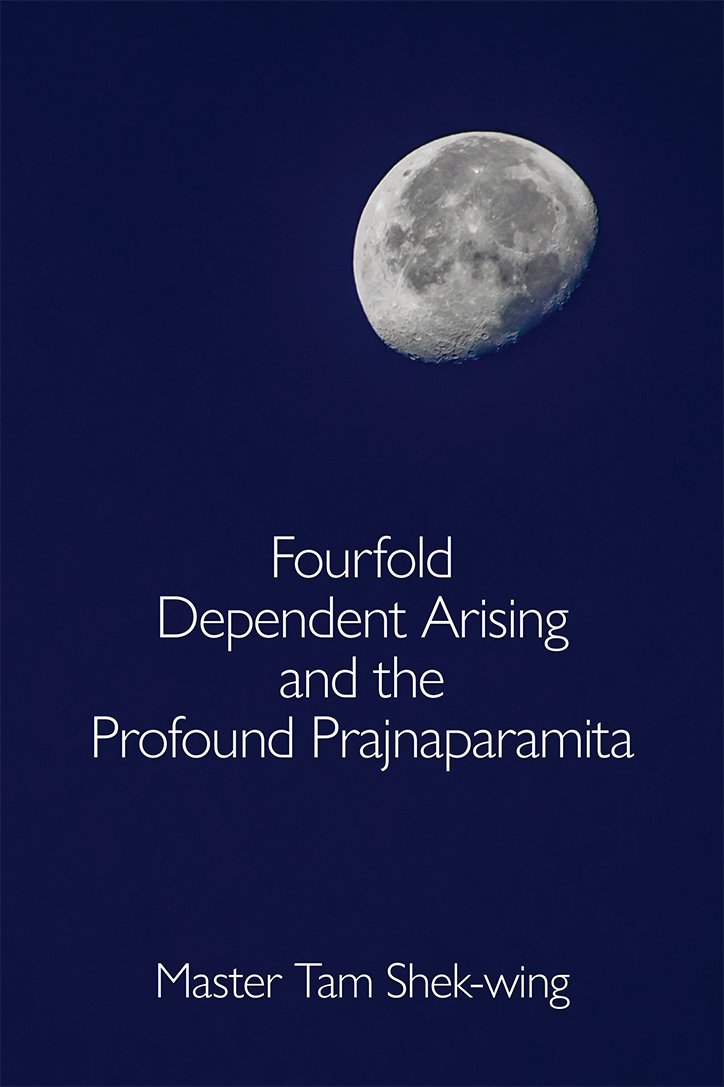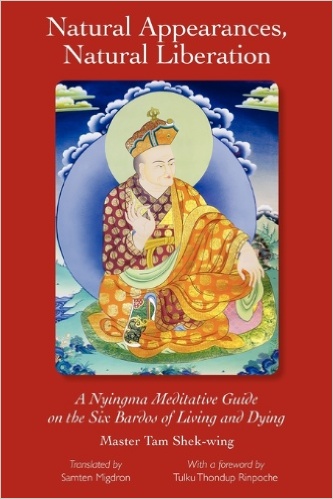Perfect Enlightenment 7: Buddha Answers Mañjuśrī, On the Perfect Awareness
Show scripture (Chinese). 爾時,世尊告文殊師利菩薩言:「善哉,善哉,善男子,汝等乃能為諸菩薩諮詢如來因地法行,及為末世一切眾生求大乘者,得正住持不墮邪見。汝今諦聽,當為汝說。」時,文殊師利菩薩奉教歡喜,及諸大眾默然而聽。 「善男子,無上法王有大陀羅尼門,名為圓覺,流出一切清淨真如、菩提涅槃、及波羅蜜,教授菩薩。一切如來本起因地,皆依圓照清淨覺相,永斷無明方成佛道。云何無明?善男子,一切眾生從無始來種種顛倒,猶如迷人四方易處,妄認四大為自身相,六塵緣影為自心相;譬彼病目見空中花及第二月。善男子,空實無花,病者妄執。由妄執故,非唯惑此虛空自性,亦復迷彼實花生處,由此妄有輪轉生死,故名無明。善男子,此無明者非實有體,如夢中人夢時非無,及至於醒了無所得;如眾空花滅於虛空,不可說言有定滅處,何以故?無生處故。一切眾生於無生中,妄見生滅,是故說名輪轉生死。善男子,如來因地修圓覺者,知是空花,即無輪轉,亦無身心受彼生死,非作故無,本性無故。彼知覺者猶如虛空,知虛空者即空花相,亦不可說無知覺性。有無俱遣,是則名為淨覺隨順。何以故?虛空性故,常不動故,如來藏中無起滅故,無知見故,如法界性究竟圓滿遍十方故;是則名為因地法行。菩薩因此於大乘中發清淨心,末世眾生依此修行不墮邪見。」 Show scripture (English). Then the World Honoured One, speaking to Mañjuśrī Bodhisattva said: “Excellent! Excellent! Good Son, you have skillfully asked on behalf of the bodhisattvas about the dharma practice of the causal ground of the Tathāgata, and on behalf of all sentient beings of the degenerate age who seek the great vehicle to gain correct abiding such that they do not fall into erroneous views. Now listen well, and I shall explain for you.” Mañjuśrī Bodhisattva received the teaching with reverence and joy; all those in the great assembly became silent and listened. “Good sons, the unsurpassed King of the dharma possesses the great dhāraṇī-entrance. It is called Perfect Enlightenment. From it is manifested all purity, suchness, bodhi, nirvāṇa and the paramitas that teach bodhisattvas. All tathāgatas in their primordially arisen causal ground rely on the perfect illumination of the appearance of pure awareness to permanently sever ignorance and directly accomplish Buddhahood.” “What is ignorance? Good sons, all sentient beings fall into various delusions since the beginningless time. Just like a disoriented person who confuses the four directions, they mistakenly take the Four Elements as the attributes of their bodies and the perceived shadows of the Six Objects as the attributes of their mind. It is just like when our eyes are diseased and we see flowers in the sky, or a second moon. Good sons, the sky actually has no flowers—they are the false attachment of the diseased person. And because of this false attachment, not only are we confused about the inherent nature of the sky, we are also mixed up about the place where real flowers come from. From this false existence there is the cycle through life and death. Therefore, it is called ignorance.” “Good sons, this ignorance actually lacks substance. It is like a man who is dreaming. At the time of the dream, there is no non-existence. But when he awakens, he finds that there is nothing for him to hold on to. Similarly, when the sky-flowers disappear from the sky, you cannot say that there is a definite place of their disappearance. Why? Because there is no point from which they arose. All sentient beings falsely perceive arising and ceasing within the non-arising. Therefore, it is said there are cycles through life-and-death.” “Good sons, in the practice of Perfect Enlightenment of the causal ground of the Tathāgata, one understands these sky-flowers, thus there are no undergoing of cyclical existences, nor body and mind to undergo life-and-death. But they are not caused and thus non-existent, because primordially insubstantial. Now, knowing this awareness is like the vast expanse, knowing this vast expanse is none other than the appearance of sky-flowers, you cannot say that this awareness is not known. Existence and non-existence both being dispelled is called in accord with pure enlightenment.” “Why? Because the nature of vast expanse, because it is eternally immovable, because the Buddha-Within is neither arising nor ceasing, and because there are no fixed points of view, like the nature of dharmadhātu it is totally complete and perfect, pervading the ten directions. Therefore, it is called the dharma practice of the causal ground. Bodhisattvas, relying upon it arouse their pure mind in the Mahāyāna, sentient beings of the degenerate age who practice relying on this will not fall into erroneous views.” In Buddha’s answer to Mañjuśrī, he said, “Good sons, the unsurpassed King of the dharma possesses the great dhāraṇī-entrance. It is called Perfect Enlightenment. From it is manifested all purity, suchness, bodhi, nirvāṇa and the paramitas that teach bodhisattvas.” According to the text, “perfect enlightenment is this great dhāraṇī-entrance, the epitome of entrances, epitomizes the dharma and other relevant teachings. From this entrance, is a manifestation of “all purity, suchness, bodhi, nirvāṇa and the paramitas.” These teachings can be seen as variations of the same dhāraṇī-entrance to perfect enlightenment. Seen in this light, it becomes obvious that this entrance is also inclusive of teachings of Madhyamaka and Yogācāra. The realization of these teachings are said to be suchness, reality, true appearances, prajñā pāramitā, selfless of the ego self, selfless of the phenomenal self, thusly like all wisdom, the epitome of all wisdom, and so on. For those who doubt the authenticity of the Sūtra of Perfect Enlightenment, their main point of contention tends to be the differences from other scriptures. This is a rather peculiar take. If every scripture expresses the same idea, then Buddha was at best a language teacher. This sūtra summarizes many relevant teachings into one definitive dhāraṇī-entrance, and since it is a definitive summary, it no longer delves into the different branches of details individually. Nowadays, many are fond of being scientific, one gets excited whenever a scientific phenomenon is in line with a saying of Buddha, which amounts to placing science above Buddhism. This is interesting. If Einstein’s physics could surpass Newtonian physics, then why could Buddha not have a great dhāraṇī-entrance that surpasses all other expedient devices? No one ever questions how Einstein’s physics differ from Newtonian physics. Sadly, the damage has been done to this sūtra; I suspect that nowadays, not too many people are willing to present it. With this trend, the hidden meaning of Buddha, Buddha’s ultimate view, his direct realization of primordial awakening, they have all suffered major damages. The scripture continues... The scripture continues, “All tathāgatas in their primordially arisen causal ground rely on the perfect illumination of the attributes of pure awareness to permanently sever ignorance and directly accomplish Buddhahood.” The perfect enlightenment that encapsulates all dharma teachings are said to be “the perfect illumination of the appearance of pure awareness.” “Perfect” means perfect and complete, the “illumination” illuminates all phenomena and all dharma. From this perfect illumination is the arising of the “the appearance of pure awareness,” in turn it perfectly illuminates all dharma. This is the perfect enlightenment, where there are in fact two kinds of wisdom, the root wisdom and the consequent wisdom. With the perfect illumination, one attains the pure awareness as the direct realization of the root wisdom, where Buddhahood is accomplished. At the same time, the consequent wisdom arises without interruption, for this attained wisdom can perfectly illuminates all mundane phenomena. The root wisdom and the consequent wisdom coalesce perpetually, we can, then, also say that the perfect illumination and the appearance of pure awareness coalesce perpetually. This perfect enlightenment is exactly the perfect enlightenment the great dhāraṇī-entrance pointed towards. The function of this perfect enlightenment is to “permanently sever ignorance and directly accomplish Buddhahood.” The accomplishment of Buddhahood is the awakening of the mind of perfect enlightenment. From the perspective of an ordinary being, how ignorance can be forever severed is the fundamental question. The scripture has clearly pointed out that ordinary beings become attached to delusionary appearances, it is akin to “when our eyes are diseased and we see flowers in the sky, or a second moon.” What is illusive is seen as substantial. Like dreaming, where the dream is seen as reality. Or like seeing sky flowers, where non-arising is seen as arising. The scripture says, “[I]n the practice of Perfect Enlightenment of the causal ground of the Tathāgata, one understands these sky-flowers, thus there are no undergoing of cyclical existences, nor body and mind to undergo life-and-death.” This “no [undergoing]” is not an intentional act causing it to disappear. Rather, it is a recognition of the nature of the cycle of life and death, its inherent nature is insubstantial, like the insubstantiality of sky-flowers and dreams. Therefore, to break free of ignorance begins with the inherent nature of things. None of the expedient (but relevant) teachings are truly ultimate. Sayings such as “none other consciousness-only” or “dependent origination is emptiness,” the so-called emptiness is a fabrication. In contrast, in Ārya-anantamukhapariśodhana-nirdeśa-parivarta-nāma-mahāyāna-sūtra (無邊莊嚴會) Ratnakūṭa (大寶積經), the three dhāraṇī-entrances taught by Buddha is the inherent emptiness. What is the inherent nature of emptiness... What is the inherent emptiness? This is why the Buddha-Within was brought up. The Buddha-Within is the buddha’s inner realm of wisdom realization, where all conventional phenomena arise (a natural spontaneous arising). Their nature is of the essence of the wisdom realm. This is analogous to a mirror image has the essence of the mirror, or the moon reflection on water has the essence of water. Taking the essence as one’s nature, when speaking of the inherent emptiness, one’s nature is naturally emptiness as well. The scripture says, “Good sons, in the practice of Perfect Enlightenment of the causal ground of the Tathāgata, one understands these sky-flowers, thus there are no undergoing of cyclical existences, nor body and mind to undergo life-and-death. But they are not caused and thus non-existent, because primordially insubstantial.” Ordinary beings are not aware of this insubstantiality, thus there is a need for the practice. The scripture says, “[K]nowing this awareness is like the vast expanse, knowing this vast expanse is none other than the appearance of sky-flowers, but you cannot say that this awareness is not known. Existence and non-existence both being dispelled is called in accord with pure enlightenment.” The perfect enlightenment is like the vast expanse, for it is the metaphor for the dharmakaya, the metaphor for buddha’s inner self-realization of wisdom, the awakening in this realm of wisdom is the perfect enlightenment. Regarding this perfect enlightenment, it cannot be “known” or “unknown.” If it were treated as knowable, there is also an attachment to the vast expanse, this awareness is no longer perfect enlightenment, but rather the thoughts on the practitioner’s mind, entirely conceptual. The scripture says, “Knowing this vast expanse is none other than the appearance of sky-flowers.” The appearance of mind is like sky-flowers. This way, the awareness cannot be said to be “perfect,” and yet, one is not without feelings. Otherwise, how is one different from a rock or a piece of wood? The practice of perfect enlightenment does not fall into the confines of knowing and unknowing, which is why it is called “in accord with pure enlightenment.” Knowing that being “in accord with pure enlightenment” is also to dispell “existences and non-existences,” the scripture continues, “Why? Because the nature of vast expanse, because it is eternally immovable, because the Buddha-Within is neither arising nor ceasing, and because there are no fixed points of view, like the nature of dharmadhātu it is totally complete and perfect, pervading the ten directions. Therefore, it is called the dharma practice of the causal ground.” It becomes clear that the practice of perfect enlightenment is the realm of direct realization of the Buddha-Within, the realm of non-arising and non-ceasing. Entering into this realm is the attainment of awareness, the perfect enlightenment. One can also expediently call this realm of Buddha-Within as the realm of dharma (dharmadhātu). One’s practice and observation of dharmadhātu, one enters into the profound prajñā pāramitā, which is the “dharma practice of the causal ground.” The above is critical so as to not fall into erroneous views. Many have damaged the teachings of perfect enlightenment and the Buddha-Within with erroneous views. Such phenomena also signify we have entered the latter days of dharma (sad-dharma-vipralopa). Show scripture (Chinese). 爾時,世尊欲重宣此義而說偈言: 文殊汝當知, 一切諸如來, Show scripture (English). Then the World Honoured One, wanting to re-emphasize the meaning of this, proclaimed a verse. He said: Mañjuśrī, you should know This verse is a comparison between wisdom and consciousness. A buddha’s wisdom awareness is equanimous, immovable, and pervades all worlds in the ten directions, the conscious experience of an ordinary being is like dreams and illusions (sky-flowers). Previously, the scripture says, “[T]hey mistakenly take the Four Elements as the attributes of their bodies and the perceived shadows of the Six Objects as the attributes of their mind.” Realizing Buddhahood can be said to be the cessation of delusions and the attainment of awareness, the delusive consciousness is transformed into the thus awareness. Be mindful of the secret meaning. The cessation of illusion does not mean there is a true place of this cessation, nor is there a location for enlightenment. The verse says, “All illusions cease at no-place / And in accomplishing the Way there is nothing attained.” Why is that? The verse continues, “The primordial nature is complete, perfect.” The awareness of this primordial nature is naturally complete and perfect. For those who reject the primordial awareness as being naturally complete and perfect, the source of contention comes from the primordial awareness being complete and perfect since the beginningless time. Does it mean that all beings are already buddhas from birth? They don’t understand that the cessation of illusion and the attainment of Buddhahood are simultaneous. Without meditation and observation, there is also no cessation of illusion, and naturally there is also no attainment of Buddhahood, nor is there the awakening of awareness that is primordial, perfect and complete. The verse continues, “In it, bodhisattvas / Are able to arouse bodhicitta / All sentient beings of the degenerate age / Practicing this, will avoid erroneous views.” This refers to the stages of practice towards the cessation of illusion, and simultaneously, the stages to allow the primordial awareness to reveal itself. In the process, the two kinds of bodhicitta are aroused. The cessation of illusion is the conventional truth; accomplishing Buddhahood is the ultimate truth. Knowing this, a practitioner would not fall into erroneous views. What is erroneous are the erroneous conceptuality. For some practitioners, they believe the seated meditation (zazen, dhyāna) is the only way to “the shedding of body and mind.” This is an erroneous view, because it is a narrow-minded pursuit of buddha-nature. Huineng (638-713), the Sixth Patriarch of Chan, said, “There is no buddha-nature.” It was said as an antidote to this contrivance. Click here for what has been posted so far in the series. Chinese:
English:
Commentary:


Chinese:
從於本因地, 皆以智慧覺,
了達於無明。 知彼如空花,
即能免流轉, 又如夢中人,
醒時不可得。 覺者如虛空,
平等不動轉, 覺遍十方界,
即得成佛道。 眾幻滅無處,
成道亦無得, 本性圓滿故。
菩薩於此中, 能發菩提心,
末世諸眾生, 修此免邪見。English:
All Tathāgatas
From their primordial arisen causal ground
Penetrate ignorance
With enlightened wisdom.
Knowing it to be like sky-flowers
They are able to escape saṃsāra.
It is like the man in the dream
Who has nothing to grasp upon awakening.
Awareness is like the vast expanse
Equal, unchanging.
Enlightenment pervading the worlds of the ten directions
Is none other than the attainment of the Buddha-way.
All illusions cease at no-place
And in accomplishing the Way there is nothing attained.
The primordial nature is complete, perfect.
In it, bodhisattvas
Are able to arouse bodhicitta
All sentient beings of the degenerate age
Practicing this, will avoid erroneous views.Commentary:



